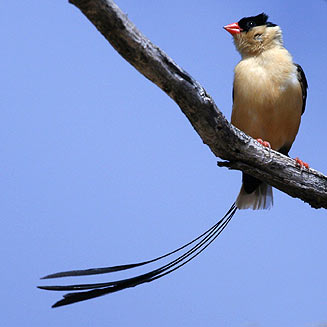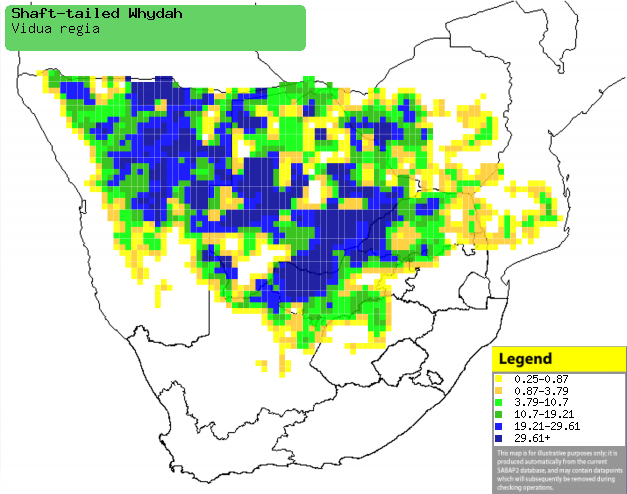|
Vidua regia (Shaft-tailed whydah)
Pylstertrooibekkie [Afrikaans]; Harusira (generic term for
whydahs) [Kwangali]; Koningswida [Dutch]; Veuve royale [French]; Königswitwe
[German]; Viúva-seta [Portuguese]
Life
> Eukaryotes >
Opisthokonta
> Metazoa (animals) >
Bilateria >
Deuterostomia > Chordata >
Craniata > Vertebrata (vertebrates) > Gnathostomata (jawed
vertebrates) > Teleostomi (teleost fish) > Osteichthyes (bony fish) > Class:
Sarcopterygii (lobe-finned
fish) > Stegocephalia (terrestrial
vertebrates) > Tetrapoda
(four-legged vertebrates) > Reptiliomorpha > Amniota >
Reptilia (reptiles) >
Romeriida > Diapsida > Archosauromorpha > Archosauria >
Dinosauria
(dinosaurs) > Saurischia > Theropoda (bipedal predatory dinosaurs) >
Coelurosauria > Maniraptora > Aves
(birds) >
Order: Passeriformes > Family: Viduidae
|
 |
|
|
Shaft-tailed whydah. [photo H. Robertson, Iziko] |
|
Distribution and habitat
Near-endemic to southern Africa, occurring from southern
Angola and south-western Zambia to Namibia (excluding the Namib Desert),
Botswana, Zimbabwe and northern South Africa, while scarce in south-central
Mozambique. It generally prefers savanna and dry woodland with rank grass,
especially with Acacia trees, also occupying fallow croplands with
Sickle-bush (Dichrostachys cinerea) and patches of grass.
|
 |
|
Distribution of Shaft-tailed whydah in southern
Africa, based on statistical smoothing of the records from first SA Bird
Atlas Project (©
Animal Demography unit, University of
Cape Town; smoothing by Birgit Erni and Francesca Little). Colours range
from dark blue (most common) through to yellow (least common).
See here for the latest distribution
from the SABAP2. |
Movements and migrations
Nomadic in the non-breeding season, especially
in the arid west where water is scarce.
Food
It mainly eats grass seeds, doing most of its foraging on
bare ground, scratching the soil to uncover food items. The following food items have been recorded
in its diet in captivity:
- Grass seeds
- Eleusine (millet)
- Panicum maximum (Guinea grass)
- Panicum schinzii (Sweet grass)
- Hyparrhenia hirta (Common thatching grass)
- Melitis repens (Natal red top)
Breeding
- It is a polygynous brood parasite, with each male defending a territory
centred on a prominent perch, which is used for calling and displaying. Its
primary host is the
Violet-eared waxbill, but it occasionally parasitises
Black-faced and
Blue waxbills.
- Egg-laying season is from December-May.
- It finds its host's nests by following one of the breeding pair or
searching suitable habitats for waxbill nests, laying a single egg per day
in sets of 3-4, with a few days break in between sets.
- The chick hatch after an incubation period of about 12-13 days and looks
very similar to Violet-eared waxbill nestlings. It is often reared in a
mixed brood alongside its host's young, leaving the nest after about 16-20
days.
Threats
Not threatened.
Referencess
-
Hockey PAR, Dean WRJ and Ryan PG 2005. Roberts
- Birds of southern Africa, VIIth ed. The Trustees of the John Voelcker
Bird Book Fund, Cape Town.
|
